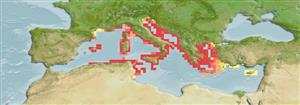Environment: milieu / climate zone / depth range / distribution range
Écologie
marin; eau douce; saumâtre benthopélagique; pH range: 6.5 - 7.5; dH range: 8 - 10; non migrateur. Subtropical; 10°C - 24°C (Ref. 1672); 46°N - 34°N, 2°E - 36°E
Europe: France, Italy, Slovenia, Croatia, Albania, Greece and Montenegro. Mediterranean basin: North Africa from Egypt to eastern Algeria, sometimes in landlocked basins; through the Suez Canal into the Bitter Lakes, Egypt (Ref. 3788). Asia: Turkey.
Taille / Poids / Âge
Maturity: Lm ? range ? - ? cm
Max length : 6.8 cm TL mâle / non sexé; (Ref. 42455)
Rayons mous anaux: 9. Can be diagnosed from other species of Aphanius, Valenciidae and Fundulidae in Europe by having the following characters: males have pale yellow to yellow-orange caudal fin, in some populations with a wide dark submarginal bar, 8-15 dark blue to grey bars on a silvery background, bars usually regularly shaped and set; females possess 11-17 short dark brown bars on sides, over a faint greyish midlateral stripe, 24-29 scales in midlateral series on body, and pectoral fin with 14-15 rays (Ref. 59043).
Occurs in coastal lagoons and in hypersaline to shallow still to slow-flowing fresh water, especially at river mouths (Ref. 59043). A short-lived species which inhabits ponds, ditches and swamps. Feeds on invertebrates and plants. Spawns from April to September (Ref. 26100). Spawning takes place on the bottom and in submerged vegetation (Ref. 59043).
Threatened due to habitat destruction and the introduction of other species (Ref. 26100). Not a seasonal killifish. Is difficult to maintain in the aquarium (Ref. 27139).
Life cycle and mating behavior
Maturité | Reproduction | Frai | Œufs | Fécondité | Larves
Freyhof, J. and B. Yoğurtçuoğlu, 2020. A proposal for a new generic structure of the killifish family Aphaniidae, with the description of Aphaniops teimorii (Teleostei: Cyprinodontiformes). Zootaxa 4810(3):421-451. (Ref. 126233)
Statut dans la liste rouge de l'IUCN (Ref. 130435)
Menace pour l'homme
Harmless
Utilisations par l'homme
Pêcheries: sans intérêt; Aquarium: Commercial
Plus d'informations
CollaborateursImagesStamps, Coins Misc.SonsCiguateraVitesseType de nageSurface branchialeOtolithesCerveauxVision
Outils
Articles particuliers
Télécharger en XML
Sources Internet
Estimates based on models
Preferred temperature (Ref.
123201): 17.6 - 20.1, mean 18.9 °C (based on 346 cells).
Phylogenetic diversity index (Ref.
82804): PD
50 = 0.5000 [Uniqueness, from 0.5 = low to 2.0 = high].
Bayesian length-weight: a=0.01000 (0.00808 - 0.01238), b=3.24 (3.20 - 3.28), in cm total length, based on LWR estimates for this species (Ref.
93245).
Niveau trophique (Ref.
69278): 2.7 ±0.27 se; based on food items.
Résilience (Ref.
120179): Haut, temps minimum de doublement de population inférieur à 15 mois (K=0.16-0.22 questionable; assuming tm<1).
Fishing Vulnerability (Ref.
59153): Low vulnerability (10 of 100).
